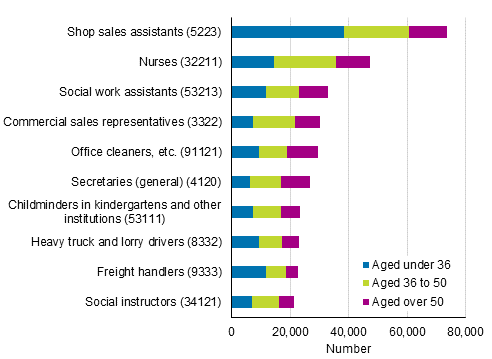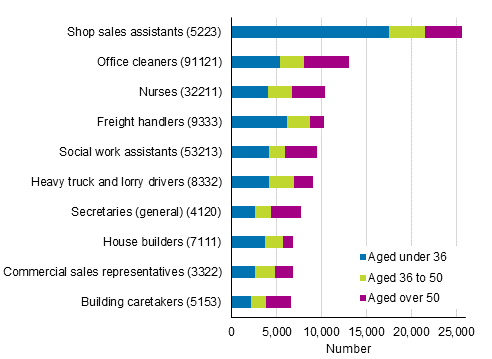Published: 20 October 2017
Wage and salary earners with families worked most as professionals in 2015
According to Statistics Finland’s employment statistics, most wage and salary earners with families were employed as professionals (338,000 persons) at the end of 2015, while wage and salary earners without families mostly worked as service and sales workers (103,000). Compared to wage and salary earners without families, relatively more wage and salary earners with families worked as professionals, technicians and associate professionals and managers, and in the armed forces. 1)
Occupational structure of wage and salary earners with families and without families in 2015

The difference in shares between persons with families and without families was biggest for professionals, 4.5 percentage points, and for technicians and associate professionals, 3.2 percentage points (Appendix tables 1b and 1c).
For wage and salary earners, the most typical occupational groups included in professionals were secondary education teachers, early childhood educators, software developers, and mechanical engineers. Among service and sales workers, the most common occupational groups of wage and salary earners were shop sales assistants, social work assistants, childminders in kindergartens and other institutions, and building caretakers. (Appendix tables 2–3.).
Most common occupational groups of wage and salary earners included in professionals in 2015
| Occupational group (AML 2010) | Wage and salary earners 2015 | Share of persons with families, % | Share of persons without families, % |
| 233 Secondary education teachers 1) | 21,181 | 82.4 | 17.6 |
| 23411 Primary education teaching professionals | 19,118 | 87.0 | 13.0 |
| 2342 Early childhood educators | 18,985 | 85.3 | 14.7 |
| 2512 Software developers | 18,232 | 74.0 | 26.0 |
| 2144 Mechanical engineers | 15,392 | 81.2 | 18.8 |
| Professionals total | 420,151 | 80.4 | 19.6 |
Most common occupational groups of wage and salary earners included in service and sales workers in 2015
| Occupational group (AML 2010) | Wage and salary earners in 2015 | Share of persons with families, % | Share of persons without families, % |
| 5223 Shop sales assistants | 99,379 | 74.2 | 25.8 |
| 53213 Social work assistants | 42,423 | 77.5 | 22.5 |
| 53111 Childminders in kindergartens and other institutions | 28,335 | 82.6 | 17.4 |
| 5153 Building caretakers | 23,813 | 72.4 | 27.6 |
| 51201 Cooks | 21,705 | 71.1 | 28.9 |
| Service and sales workers total | 416,571 | 75.3 | 24.7 |
Most common occupational groups almost the same for wage and salary earners with and without families
The groups of the ten most common occupational groups for wage and salary earners with and without families differed from each other only in few cases like childminders in kindergartens and other institutions, social instructors, house builders, and building caretakers (Appendix tables 4b and 4c).
The average age and median of wage and salary earners with families were 42 years. In turn, the average age of wage and salary earners without children was 40 years and the median age was 38 years.
Most common occupational groups of wage and salary earners with families in 2015

Most common occupational groups of wage and salary earners without families in 2015

Share of persons with families biggest in the occupational group of managers
The share of persons with families 2) in wage and salary earners was nearly 90 per cent in many occupational groups included in managers, such as manufacturing managers, managing directors and chief executives, and retail and wholesale trade managers. The share of persons with families in occupational groups not included in managers was the biggest for private childminders and public health nurses, 88 per cent. (Appendix table 5a.).
Correspondingly, the share of persons without families 3) in all wage and salary earners’ occupational groups was not very high in any occupational group, but was at most under 50 per cent. The shares of those without families were biggest among plasterers, around 50 per cent, among bartenders (45 per cent), among announcers on radio, television and other media (43 per cent), and among croupiers and related gaming workers (41 per cent). (Appendix table 5b.).
In Statistics Finland's employment statistics for 2015, the occupations of wage and salary earners and entrepreneurs aged 18 to 74 have been classified into occupational groups according to the Classification of Occupations 2010. 4) 5)
1) A family is formed by married or cohabiting couples or those in registered partnerships and their children, by one of the parents with their children and by married and cohabiting couples and registered partners without children. The child's age is not significant. The occupational groups are in accordance with the Classification of Occupations 2010.
2) Of occupational groups with at least 150 persons.
3) Of occupational groups with at least 150 persons.
4) Occupation data are produced primarily based on a person's main employment in the last week of the year.
5) Data on occupation was unknown for around 3.8 per cent of all wage and salary earners, for around 3.5 per cent of all wage and salary earners with families and for about 4.6 per cent of all wage and salary earners without families in 2015.
Source: Employment Statistics, Statistics Finland
Inquiries: Elina Mikkelä 029 551 2973, info@stat.fi
Director in charge: Jari Tarkoma
Publication in pdf-format (333.3 kB)
- Tables
-
Tables in databases
Pick the data you need into tables, view the data as graphs, or download the data for your use.
Appendix tables
- Appendix table 1a. Occupational structure of wage and salary earners aged 18 to 74 in 2015 1) (20.10.2017)
- Appendix table 1b. Occupational structure of wage and salary earners with families aged 18 to 74 in 2015 1) (20.10.2017)
- Appendix table 1c. Occupational structure of wage and salary earners without families aged 18 to 74 in 2015 1) (20.10.2017)
- Appendix table 2a. Most common occupational groups of wage and salary earners aged 18 to 74 included in the group of professionals in 2015 1) (20.10.2017)
- Appendix table 2b. Most common occupational groups of wage and salary earners aged 18 to 74 with families included in the group of professionals in 2015 1) (20.10.2017)
- Appendix table 2c. Most common occupational groups of wage and salary earners aged 18 to 74 without families included in the group of professionals in 2015 1) (20.10.2017)
- Appendix table 3a. Most common occupational groups of wage and salary earners aged 18 to 74 included in the group of service and sales workers in 2015 1) (20.10.2017)
- Appendix table 3b. Most common occupational groups of wage and salary earners aged 18 to 74 with families included in the group of service and sales workers in 2015 1) (20.10.2017)
- Appendix table 3c. Most common occupational groups of wage and salary earners aged 18 to 74 without families included in the group of service and sales workers in 2015 1) (20.10.2017)
- Appendix table 4a. Most common occupational groups of wage and salary earners aged 18 to 74 by sex and age in 2015 1) (20.10.2017)
- Appendix table 4b. Most common occupational groups of wage and salary earners aged 18 to 74 with families by sex and age in 2015 1) (20.10.2017)
- Appendix table 4c. Most common occupational groups of wage and salary earners aged 18 to 74 without families by sex and age in 2015 1) (20.10.2017)
- Appendix table 5a. Biggest shares of wage and salary earners with families of all wage and salary earners aged 18 to 74 in the occupational group in 2015, % 1) (20.10.2017)
- Appendix table 5b. Biggest shares of wage and salary earners without families of all wage and salary earners aged 18 to 74 in the occupational group in 2015, % 1) (20.10.2017)
Updated 20.10.2017
Official Statistics of Finland (OSF):
Employment [e-publication].
ISSN=2323-6825. Industry, employer sector and jobs 2015. Helsinki: Statistics Finland [referred: 20.4.2025].
Access method: http://stat.fi/til/tyokay/2015/04/tyokay_2015_04_2017-10-20_tie_001_en.html

